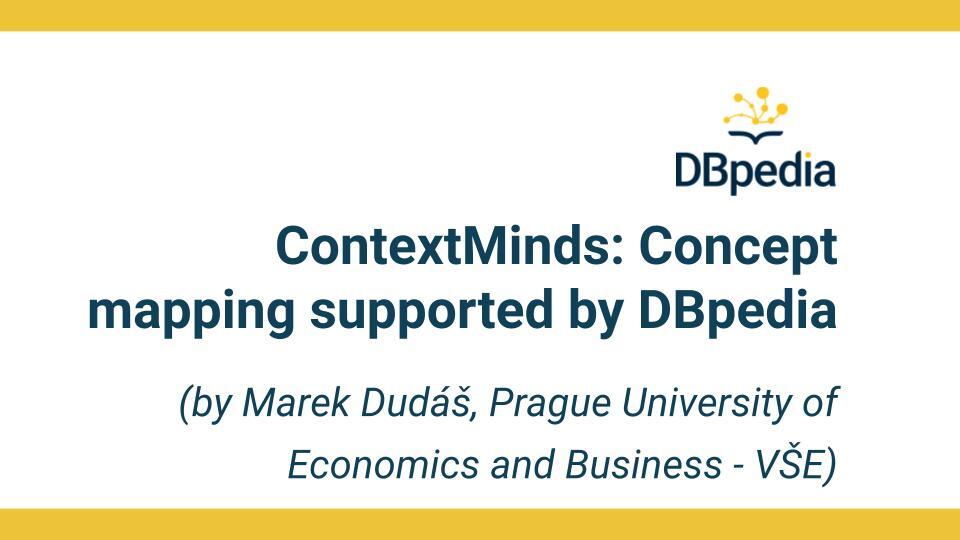Contribution from Marek Dudáš (Prague University of Economics and Business – VŠE)
ContextMinds is a tool that combines two ideas: concept mapping and knowledge graphs. What’s concept mapping? With a bit of simplification, when you take a small subgraph of not more than a few tens of nodes from a knowledge graph (kg) and visualize it with the classic node-link (or “bubbles and arrows”) approach, you get a concept map. But concept maps are much older than knowledge graphs. They emerged in the 70’s and were originally intended to be created by hand. This was done to represent a person’s understanding of a given problem or question. Shortly after their “discovery” (using diagrams to represent relationships is probably much older idea), they turned out to be a very useful educational tool.
Going back to knowledge graphs and DBpedia, ContextMinds lets you quickly create an overview of some problem you need to solve, study or explain.

How you can start
Starting from a classic text search, you select concepts (nodes) from a knowledge graph, ContextMinds shows how they are related (loads the links from the knowledge graph). It also suggest you what other concepts are there in the kg that you might be interested in. The suggestions are brought from the joint neighborhood of the nodes you already selected and put into the view. Nodes are scored by relevance, basically by the number of links to what you have in the view. So, as you are creating your concept map, an always updated list of around 30 most related concepts is available for simple drag & dropping to your map.

This helps you make the concept map complete quickly. It also helps to discover relationships between the concepts that you were not aware of. If a concept or relationship is not there yet in the knowledge graph, you can create it. It will not only appear in your concept map, but will also become a part of an extended knowledge for anyone who has access to your map. You can at any time select the sources of concept & relationship suggestions. To do that you can choose any combination of the personal scope (concepts from maps created by you), workspace scope (shared space with teammates), DBpedia (or a different kg) and public scope (everything created by the community and made public).
The best way of explaining how it works is a short video.
Use Case: Knowledge Graph
ContextMinds was of course built with DBpedia as the initial knowledge graph. That instance is available at app.contextminds.com and more than 100 schools are using it as an educational aid. Recently, we discovered that the same model can be useful with other knowledge graphs.
Say you run some machine learning that helps you identify some objects in the knowledge graph as having some interesting properties. Now you might need to look at what is there in the graph about them to either explain the results or show the results to domain experts so that they can use them for further research. And that is where ContextMinds comes in. You put the concepts from the machine learning results into the view and ContextMinds automatically adds the links between them and finds related concepts from their neighborhood. We have done this with kg-covid, a knowledge graph built from various biomedical and Covid-related datasets. There we use RDFrules to mine interesting rules and then visualize the results in ContextMinds (available at contextminds.vse.cz). Because of that biology experts may interpret them and explore further related information. More about that maybe later in another blogpost.

Our Vision
An additional fun fact: since we started developing ContextMinds to work solely with DBpedia, its data model is kind-of hard-coded in it. Although the plan is to enable loading multiple knowledge graphs into single ContextMinds instance so that the user may interconnect objects from DBpedia with those from other datasets when creating the concept map at the moment we have to transform the data so that they look like DBpedia to be loaded into ContextMinds.
A big thank you to ContextMinds, especially Marek Dudáš for presenting how ContextMinds combines concept mapping and knowledge graphs.
Yours,
DBpedia Association
- Did you consider this information as helpful?
- Yep!Not quite ...

